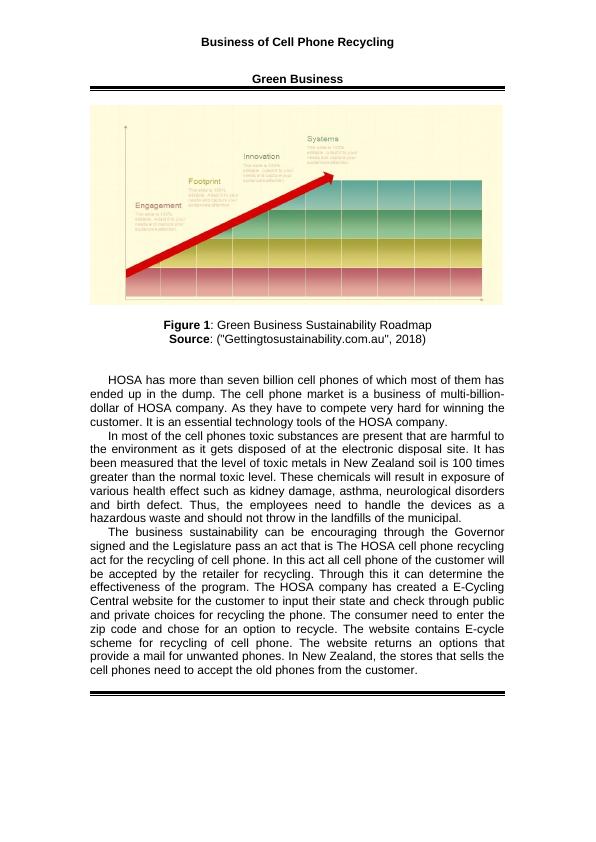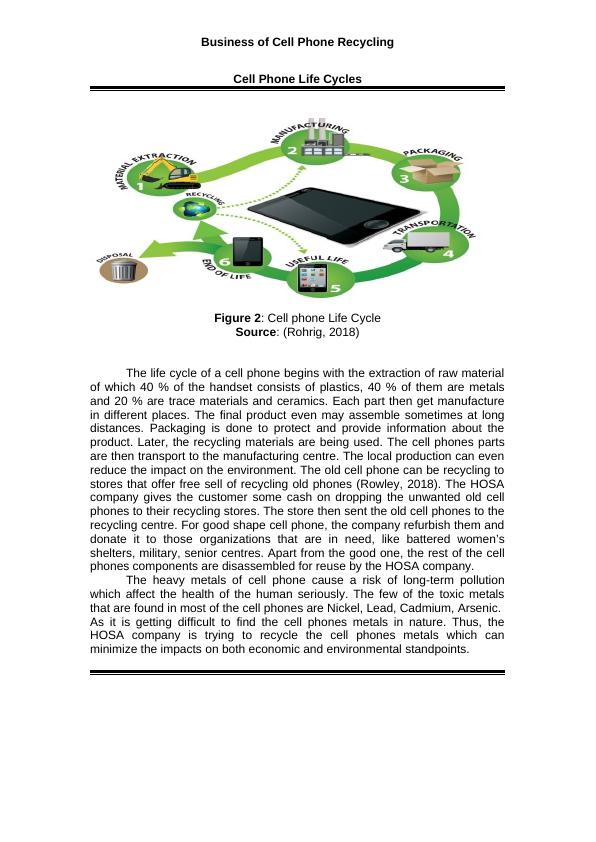Business of Cell Phone Recycling
10 Pages2283 Words33 Views
Added on 2021-06-14
Business of Cell Phone Recycling
Added on 2021-06-14
ShareRelated Documents
Business of Cell Phone RecyclingBusiness of Cell Phone RecyclingName of the StudentName of the UniversityAuthor Note

Business of Cell Phone RecyclingGreen BusinessFigure 1: Green Business Sustainability RoadmapSource: ("Gettingtosustainability.com.au", 2018)HOSA has more than seven billion cell phones of which most of them hasended up in the dump. The cell phone market is a business of multi-billion-dollar of HOSA company. As they have to compete very hard for winning thecustomer. It is an essential technology tools of the HOSA company. In most of the cell phones toxic substances are present that are harmful tothe environment as it gets disposed of at the electronic disposal site. It hasbeen measured that the level of toxic metals in New Zealand soil is 100 timesgreater than the normal toxic level. These chemicals will result in exposure ofvarious health effect such as kidney damage, asthma, neurological disordersand birth defect. Thus, the employees need to handle the devices as ahazardous waste and should not throw in the landfills of the municipal. The business sustainability can be encouraging through the Governorsigned and the Legislature pass an act that is The HOSA cell phone recyclingact for the recycling of cell phone. In this act all cell phone of the customer willbe accepted by the retailer for recycling. Through this it can determine theeffectiveness of the program. The HOSA company has created a E-CyclingCentral website for the customer to input their state and check through publicand private choices for recycling the phone. The consumer need to enter thezip code and chose for an option to recycle. The website contains E-cyclescheme for recycling of cell phone. The website returns an options thatprovide a mail for unwanted phones. In New Zealand, the stores that sells thecell phones need to accept the old phones from the customer.

Business of Cell Phone RecyclingCell Phone Life Cycles Figure 2: Cell phone Life CycleSource: (Rohrig, 2018)The life cycle of a cell phone begins with the extraction of raw materialof which 40 % of the handset consists of plastics, 40 % of them are metalsand 20 % are trace materials and ceramics. Each part then get manufacturein different places. The final product even may assemble sometimes at longdistances. Packaging is done to protect and provide information about theproduct. Later, the recycling materials are being used. The cell phones partsare then transport to the manufacturing centre. The local production can evenreduce the impact on the environment. The old cell phone can be recycling tostores that offer free sell of recycling old phones (Rowley, 2018). The HOSAcompany gives the customer some cash on dropping the unwanted old cellphones to their recycling stores. The store then sent the old cell phones to therecycling centre. For good shape cell phone, the company refurbish them anddonate it to those organizations that are in need, like battered women’sshelters, military, senior centres. Apart from the good one, the rest of the cellphones components are disassembled for reuse by the HOSA company. The heavy metals of cell phone cause a risk of long-term pollutionwhich affect the health of the human seriously. The few of the toxic metalsthat are found in most of the cell phones are Nickel, Lead, Cadmium, Arsenic. As it is getting difficult to find the cell phones metals in nature. Thus, theHOSA company is trying to recycle the cell phones metals which canminimize the impacts on both economic and environmental standpoints.

End of preview
Want to access all the pages? Upload your documents or become a member.
Related Documents
E-Waste Recycling: Definition, Environmental, Economic and Social Issueslg...
|10
|653
|185
